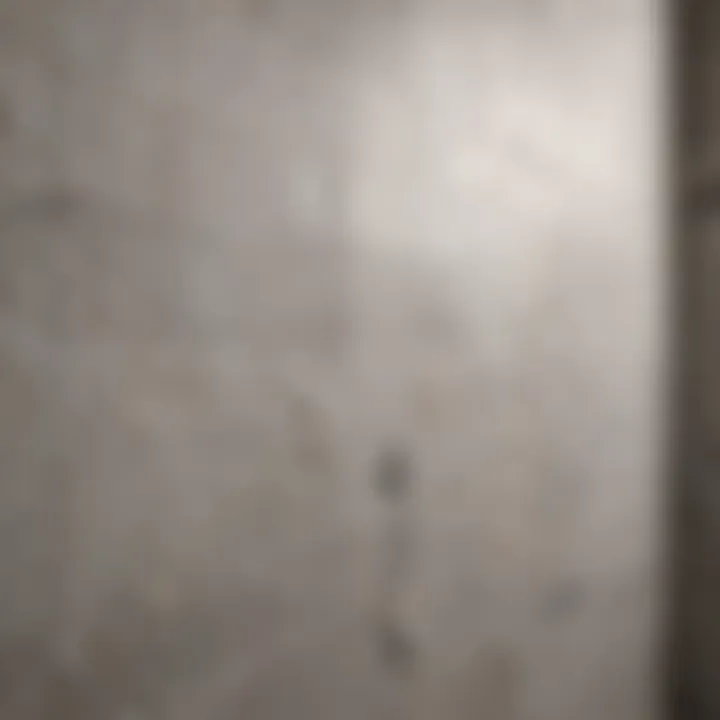Comprehensive Guide to Bathroom Wall Tiling Costs


Intro
Tiling bathroom walls is a crucial element of any renovation project. It serves not only aesthetic purposes but also practical ones, such as protecting walls from moisture. However, understanding the costs involved can be daunting. Homeowners and design enthusiasts need to take a few factors into account to make informed decisions. This article will explore essential costs associated with tiling bathroom walls, from tile choices to labor expenses. By understanding these factors, you can better estimate your budget and avoid unforeseen surprises.
Design Inspiration
Current Interior Design Trends
Today, bathroom design trends focus on creating serene environments. Minimalism continues to gain popularity, emphasizing clean lines and uncluttered spaces. Natural materials like ceramic and stone tiles are favored for their durability and aesthetic appeal. Geometric patterns and bold designs also make a statement, adding an element of individuality.
Some trends include:
- Large-format tiles that provide a seamless look
- Textured tiles, which add depth and interest
- Eco-friendly materials reflecting a commitment to sustainability
These trends can significantly influence tile prices. Unique or designer tiles often come at a higher cost than standard options.
Color Palettes and Their Effects
Color choices in bathroom tiling can dramatically affect the overall feel of the space. Lighter colors can make small bathrooms appear larger, while darker shades add warmth and coziness.
Some popular color combinations include:
- Soft blues and whites for a calming effect
- Grays and blacks for a modern touch
- Earthy tones that evoke a natural ambiance
When selecting colors, consider their long-term appeal. Trends can change, but classic color palettes tend to withstand the test of time. This could save more money in the long run.
Tile Material Costs
The type of tile chosen is often the biggest cost influencer when tiling bathroom walls. Common materials include:
- Ceramic: Affordable and available in various styles and colors.
- Porcelain: Denser and more resistant to moisture, making it ideal for bathrooms, although pricier.
- Natural Stone: Offers unique aesthetics but comes with higher installation and maintenance costs.
It's advisable to balance personal preference with budget constraints.
Labor Expenses
Hiring a professional for tile installation is often recommended for optimal results. Labor costs vary depending on region and complexity of the job. You should expect to pay between $4 to $8 per square foot for installation. It can be beneficial to obtain multiple quotes from contractors to ensure competitive pricing.
"Investing in a good installation can enhance the longevity and appearance of your tile work."
Preparation and Maintenance Considerations
Before tiling, adequate preparation is essential. This involves surface cleaning, leveling, and potentially waterproofing. These tasks can affect overall costs. Maintenance after installation is also a consideration. Regular cleaning and resealing natural stone tiles can be labor intensive and add to long-term expenses.
In summary, it is vital to recognize that various factors influence the cost of tiling bathroom walls. From tile choice to labor and maintenance, understanding these elements leads to smarter, more informed decisions when renovating your bathroom.
Prelims to Bathroom Tiling Costs
Tiling bathroom walls is a significant investment for homeowners and design enthusiasts alike. Understanding the costs associated with this endeavor is essential for effective budgeting and decision-making. This section provides a foundation for analyzing tiling costs, focusing on key factors that influence pricing and the overall impact on home renovations.
Understanding the Basics
Bathroom tiling costs are shaped by multiple components. These include the type of tiles selected, labor charges, and preparation processes required before installation. Homeowners need to comprehend these basics to effectively navigate their options. The materials chosen, whether ceramic, porcelain, or natural stone, can drastically alter the project's cost.
Labor will also play a critical role. This covers not just the installation but also any necessary repairs or modifications to the underlying surfaces. The more intricate the design, the higher the labor costs may rise.
Investing time to understand these foundational aspects can help prevent unexpected expenses and facilitate better planning.


Importance of Budgeting
Budgeting for bathroom tiling is a crucial part of the renovation process. It ensures that homeowners allocate sufficient funds for materials, labor, and additional costs such as permits or tools.
When approaching a tiling project, it can be beneficial to create a detailed budget plan. This might include:
- Material Costs: Research and select tiles that fit within your financial constraints.
- Labor Costs: Get quotes from multiple contractors to find competitive rates.
- Preparation Expenses: Consider costs related to removing old tile or fixing wall imperfections.
Effective budgeting allows for flexibility during the renovation process, helping to avoid financial strain and ensuring that the project can proceed without unnecessary delays.
By prioritizing budgeting, homeowners can achieve a balance between aesthetics and functionality, leading to a more satisfying outcome that aligns with their financial capabilities.
Factors Influencing Tiling Costs
Understanding the factors influencing tiling costs is crucial for anyone considering a bathroom renovation. These elements directly affect the overall expenses and can help in making informed choices. Knowing what drives pricing allows homeowners to budget effectively and avoid surprises during the project.
Material Selection
Types of Tiles
The type of tile selected for a bathroom wall plays a significant role in determining costs. Common types include ceramic, porcelain, and natural stone. Ceramic tiles are often seen as a cost-effective option, offering various designs and colors. They are widely popular for their ease of installation and maintenance. In contrast, porcelain tiles tend to be denser and more durable, making them suitable for high-moisture areas, although they come with a higher price tag. Natural stones like marble or granite provide a luxurious appearance but typically require more investment. Each type has its unique feature, which can either elevate the aesthetic or fit the budget.
Tile Quality and Durability
When considering tiles, quality and durability cannot be overlooked. Higher quality tiles usually mean better resistance to scratches, stains, and moisture. While these enduring options tend to cost more upfront, they may save money over time through lower maintenance needs and longer life. Opting for lower-quality tiles might seem economical initially, yet they can incur more costs in repairs or replacements sooner than expected. Investing in durable tiles can also contribute positively to the overall value of the home.
Cost Comparison Among Materials
The diversity of materials available can lead to significant price variations. For instance, ceramic tiles can range from budget-friendly options to premium styles, making them accessible for various budgets. Conversely, natural stones generally represent a higher starting price but benefit from unique designs and higher resale value. Comparing costs among materials enables homeowners to match their aesthetic preferences with budget constraints, ensuring they make informed decisions that do not compromise quality.
Labor Costs
Hourly Rates
Understanding the hourly rates of labor is essential in estimating total renovation costs. Prices can vary based on location, skill level, and demand for services. Employing seasoned professionals might demand a greater outlay than hiring less experienced workers, but it can often yield superior results. Furthermore, local market rates can significantly influence how much one should budget for labor in their tiling project.
Experience and Expertise
Experience and expertise of the tilers also play a critical role in the cost calculations. Skilled workers who have spent years honing their craft may charge more, yet their proficiency can lead to a more seamless installation process. Experience reduces the likelihood of costly errors during installation which ultimately benefits budget considerations. Investing in expert labor may enhance the quality of the tiling job, making it worth the extra expense.
Long-Distance Considerations
Long-distance considerations add another layer to labor costs. If the chosen contractor is not located nearby, transportation expenses can increase the total cost. Additionally, waiting times can extend if certain materials must be transported from afar. Evaluating these aspects ensures that the final budget aligns with realistic expectations and allows for informed planning.
Preparation and Installation
Surface Preparation Needs
Before any tiles are laid, surface preparation is paramount. This step can involve cleaning, leveling, or installing backer boards, which adds to labor and material costs. Proper preparation prevents future complications like tiles cracking or coming loose. Moreover, ensuring the surface is correctly prepared reduces the likelihood of additional expenses due to installation issues later.
Additional Installation Requirements
Certain projects might have additional installation requirements that affect total costs. These can include specific substrates for different tile types or the need for specialized sealing and grouting. A thorough evaluation of these necessities up front will aid in creating a more accurate budget, ensuring no unexpected costs arise.
Timeframes for Completion
The timeframes for project completion can vary significantly and impact final costs. Rushed jobs may incur additional charges while jobs that proceed methodically can lead to better-quality outcomes. Understanding realistic timeframes helps in planning and can aid in avoiding last-minute expenses. Homeowners should discuss these timeframes with their contractors to gain a better understanding of the logistical impact on costs.


Estimating Total Costs
Estimating the total costs associated with tiling bathroom walls is essential for any renovation project. This process involves analyzing various financial aspects that can impact the homeowner’s budget. By understanding these costs, homeowners can make better decisions related to their projects, ensuring that they remain within their financial limitations while achieving their desired aesthetic and functional outcomes.
Knowing the total costs helps in planning effectively. It allows homeowners to prioritize spending and allocate funds appropriately across different areas of the project, such as materials, labor, and additional features. Also, having a clear estimate can reduce stress and uncertainty, making the remodeling process smoother.
Cost Breakdown by Area
Per Square Foot Pricing
Per square foot pricing is an important aspect to consider when analyzing wall tiling costs. It provides a straightforward way to assess expenses based on the area needing coverage. Most contractors will calculate estimates by this metric, making it easier to understand how much the tiling will cost proportionate to the size of the bathroom.
One of the key characteristics of per square foot pricing is its simplicity. It allows homeowners to quickly gauge overall expenses without complex calculations. This pricing model is also popular because of its transparency. Homeowners can compare quotes from different contractors or suppliers based on the same square footage. However, it's important to recognize that this model may not account for additional factors like intricate designs or special requirements, which can influence the final price.
The unique feature of this approach is that it helps in clarifying the costs before starting the project. For homeowners, knowing how much they may spend per square foot can help avoid unexpected expenses later. Still, they should keep in mind that this method does not give a complete picture, as certain details may require separate budgeting.
Overall Project Cost Estimates
Overall project cost estimates encapsulate more than just material prices. They offer a comprehensive view of the entire tiling project by factoring in elements like labor, preparation, and potential unexpected expenses. This is crucial for budgeting as it helps homeowners understand the total financial impact of their design choices.
One of the notable aspects of overall project cost estimates is their inclusivity. They take into account all essential components involved in the tiling process. Homeowners appreciate this approach because it reflects a more accurate representation of what they will actually pay once the project is completed. However, obtaining a precise estimate requires detailed information about the project scope and any unique elements that might affect costs.
The key benefit of comprehensive project estimates lies in helping homeowners effectively allocate their budgets. It answers not just how much per square foot, but what the total financial commitment will be, prompting more informed decisions throughout the tiling process.
Variable Costs Based on Design Complexity
Variable costs based on design complexity refer to the fluctuating expenses that arise from unique design elements, such as intricate layouts, patterns, and customizations. These costs can significantly impact the overall budget of a tiling project, making it necessary to factor them into any total cost estimates.
One distinguishing feature of variable costs is their unpredictability. Unlike fixed costs, which remain stable, these expenses change based on the project’s specifications. Homeowners often find this aspect challenging but important, as complex designs may require additional materials or specialized labor, leading to increased pricing.
The benefit of understanding variable costs is that it prepares homeowners for potential changes in their budget. By anticipating how design choices can influence costs, they can adjust their plans accordingly. However, the downside is that it can introduce uncertainty in budgeting, necessitating clear communication with contractors for accurate estimates.
Using Cost Calculators
Using cost calculators can simplify the budgeting process for homeowners. These tools provide a practical way to estimate the total costs associated with tiling bathroom walls. A cost calculator often considers various metrics, including material types, labor rates, and area size, making it easier for users to arrive at a realistic estimate with minimal effort.
The primary advantage of utilizing a cost calculator is efficiency. It saves homeowners time, as they do not need to manually gather and calculate all costs themselves, which can be cumbersome. Furthermore, many calculators are tailored for specific projects, enhancing their accuracy, and offering insights tailored to the homeowner's needs.
However, calculators can only provide rough estimates. Real-life costs might vary depending on local labor rates and specific material choices. Thus, they should be used as a starting point. Homeowners should still engage with professionals to confirm their estimates and to ensure that their financial planning aligns with practical expectations.
Comparative Analysis of Tiling Options
Understanding the comparative analysis of tiling options is crucial for homeowners and design enthusiasts embarking on a bathroom renovation. This section provides insights into material choices that significantly affect both the initial costs and long-term value of tiled walls. Each option varies in durability, maintenance needs, and overall aesthetic appeal. By evaluating these factors, one can make informed decisions that align with both practical requirements and personal design preferences.
Ceramic vs. Porcelain
Ceramic and porcelain tiles are two prominent choices in bathroom wall tiling. Both materials share similarities but have distinct differences that can influence your decision.
Ceramic Tiles:
Ceramic tiles are made from clay that is fired at high temperatures. They are popular due to their affordability and variety of designs. These tiles are relatively easy to install, making them suitable for DIY projects. However, ceramic tiles tend to absorb more water than porcelain, so they may not be the best choice for high-moisture areas unless they are glazed properly.
Porcelain Tiles:
Porcelain tiles, on the other hand, are denser and less porous. This characteristic makes them more water-resistant and durable compared to their ceramic counterparts. They are often used in commercial spaces or areas expected to endure high traffic. The initial cost of porcelain tiles may be higher, but their longevity can yield better value over time.
In summary, while ceramic tiles are often more budget-friendly initially, porcelain tiles provide superior performance in wet environments, which may result in fewer repairs or replacements in the long run.
Natural Stone Considerations


Natural stone tiles, such as marble, granite, or slate, offer a unique aesthetic that is appealing to many homeowners. However, they come with both advantages and disadvantages that must be considered.
Advantages:
- Beauty and Uniqueness: Each piece is distinctive, adding character to your bathroom.
- Durability: Many natural stones are extremely durable, resistant to wear over time.
Disadvantages:
- Maintenance: Natural stone often requires regular sealing to protect against moisture and stains.
- Cost: The price of natural stone can be significantly higher than ceramic or porcelain options.
Water-Resistant Alternatives
While traditional tiling options like ceramic and porcelain serve their purpose well, water-resistant alternatives are becoming popular among homeowners seeking extra protection against moisture and mold.
Vinyl Tiles:
Vinyl tiles are known for their affordability and ease of installation. They are also water-resistant, making them a practical choice for bathrooms. Their designs can mimic the look of natural stone or wood, providing aesthetics without the high maintenance associated with these materials.
Glass Tiles:
Glass tiles are another worthy mention. They are non-porous and reflect light beautifully, adding a modern touch. However, the installation can be more complicated, and costs may run higher depending on the type and quality.
When evaluating water-resistant alternatives, consider the long-term performance versus initial investment. Each option has its merits and should match your specific needs and style preferences.
Long-Term Cost Considerations
When embarking on a bathroom renovation involving tile work, understanding long-term cost considerations is crucial. This section helps homeowners and design enthusiasts grasp how tiling choices can affect finances well beyond the initial installation. The quality of materials, maintenance requirements, and potential resale value are all intertwined and can either save or cost additional money over time.
Maintenance Costs
Maintenance is a significant aspect often overlooked in the budgeting process. Different tile materials come with varying upkeep needs. For instance, ceramic and porcelain tiles are generally low maintenance. They can be cleaned easily with standard household cleaners. Contrast that with natural stone tiles that may require sealing periodically and specific cleaning products.
Regular maintenance involves costs such as cleaning supplies, repair kits, and potentially hiring professionals for deep cleaning or repairs. It's wise to factor in these expenses into your initial budget. For example:
- Ceramic Tiles: Require minimal care; typically, just sweeping and mopping are sufficient.
- Natural Stone Tiles: Need regular sealing every few years, with sealant costing between $20 to $50 depending on the product.
- Porcelain Tiles: Similar maintenance to ceramic but may need special tools for chips or cracks.
In the long run, investing in higher quality tiles can translate to lower maintenance costs and longer lifespans.
Resale Value Impact
The impact of tiling choices on resale value is often overlooked. A well-tiled bathroom can significantly enhance the overall appeal of a home. Buyers frequently seek spaces that reflect quality and style. If you opt for high-quality and trendy tiles, it could lead to a favorable return on investment when selling the property.
Consider the following points regarding resale value:
- Quality of Materials: Homes featuring natural stone or high-end ceramic might list for a higher market price.
- Design Trends: Keeping up with current design trends can make a bathroom more desirable. Outdated tiles could decrease interest among potential buyers.
- Condition of Installation: Poorly installed tiles can not only detract from aesthetic appeal but also signal neglect, impacting overall home valuation.
"Investing in quality tiling can offer not just immediate satisfaction but also long-term value addition to your property." This underscores the importance of evaluating the overall benefits versus the costs involved in bathroom renovation projects.
In summary, when planning a bathroom tiling project, do not solely concentrate on upfront costs. Maintenance needs and potential resale value are fundamental components that ensure the investment remains sound over time.
Ending and Recommendations
Summary of Insights
Throughout the previous sections, we have explored various factors affecting the costs of tiling bathroom walls. Key insights include:
- Material Influence: The choice of tile, whether ceramic, porcelain, or natural stone, significantly impacts costs. Each material offers different aesthetics and durability, which must align with your renovation goals.
- Labor Considerations: Hiring skilled professionals may seem costly upfront, but their experience can save time and provide a higher-quality installation. Evaluating local labor rates can aid in accurate budgeting.
- Preparation Needs: Proper preparation is vital. This may include resurfacing walls or fixing plumbing issues before tiling. Skipping this step may lead to increased future costs.
- Maintenance Implications: Long-term maintenance should be factored into initial pricing. Ceramic tiles, for instance, may require less upkeep compared to natural stone.
"Planning for both initial and long-term costs creates a more realistic budget. It sets the stage for a successful remodeling process."
Final Thoughts on Cost Efficiency
Cost efficiency in tiling bathroom walls is achievable through informed decision-making. Consider the following recommendations to maximize your investment:
- Do Thorough Research: Look into different materials and their long-term benefits. Websites like Wikipedia can provide fundamental knowledge about tile characteristics.
- Calculate Total Costs: Use cost calculators available online to get a comprehensive overview of what the project might require financially. Websites like Reddit often have discussions where other users share their experiences and advice.
- Consult Professionals: Engage with experienced installers who can provide insights into potential hidden costs and best practices for your specific space.
- Plan Ahead: Allocate a portion of your budget for unexpected expenses. Renovations often uncover issues that need immediate attention.
By implementing these recommendations, homeowners can ensure that their tiling project will not only enhance the beauty of their bathrooms but also be financially viable in the long run. Keeping a balanced perspective on initial costs, quality, and maintenance requirements will create a more satisfying and economically sound renovation process.















